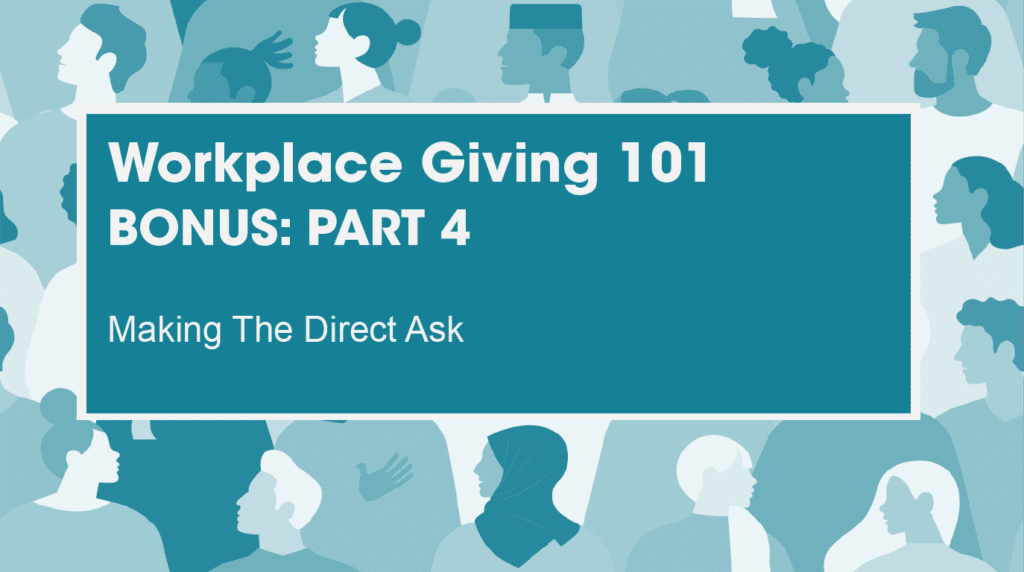Welcome to our bonus installment of the Workplace Giving 101 blog series, with a very special guest blog from Natalie Jacobsen, as she delves into “making the ask” of your co-workers to contribute to your annual employee giving campaign. Natalie focuses on the very specific, tactical ways to ask your co-workers to contribute – on a personal level, that will encourage people to give to the causes that they care about.
Haven’t read the first three parts? You can look at those here:
I. Workplace Giving 101: The Impact of Workplace Giving Campaigns
II. Workplace Giving 101: Engage Leadership and Build a Team
III. Workplace Giving 101: Launch and promote with pizazz
So, you’ve been asked to serve as a workplace giving campaign volunteer. While you are ready to give it a try and learn something new, you might be a little concerned about how to ask your co-workers to give. You are not alone! Many people feel anxious about speaking to your colleagues when it comes to money and donations.
The good news: you CAN do this! Follow our advice, right down to the script, and you will develop a great skill not only for this workplace giving campaign, but also to carry through to you the rest of your professional and personal life.
The secret most charismatic people have is this: they all started in the same place as you. Over time, they built up the skills to be bold.
The Easy Part: An Email
One of the easiest outreaches you can do first is: the mass email. It is a great place to put yourself out there without facing the team just yet. It is a safe place to test the waters and see the initial response.
Take the email list you have been given and craft your first outreach.
We have made it easy for you and pre-written several of the email templates that you will use during your campaign. Click here for complimentary access to our templates.
Make sure you explain the campaign, introduce the charity list, recap any rewards or benefits offered, and instructions on how to give. It’s a great idea to introduce yourself so the team knows who you are, and you’ve asserted yourself as the person they talk to about the campaign. Don’t forget your call to action!
After you send the first email, take a deep breath. You’ve done it. The first big leap. That’s a great first-day outreach, and many veterans of the campaign or employees who’ve been around longer may automatically give the moment they see your email. Others – new or who are slower to give– will require more effort.
The Most Challenging: The Personal Ask
Group emails are just the first points of contact – but the individual ones will be more personal, meaningful, and reach those who jumped on the group call but kept working through it instead of giving their full attention. The number one reason a person gives to charity is that they were invited to do so by someone they trust. That is why talking with your co-workers about the campaign more directly is so important.
The components of your ask are simple. You want to be knowledgeable and lead by example, becoming the go-to resource for all things campaign-related. Use your own experiences and emotions to connect with your co-workers on a personal level, and explain all of the options and benefits of giving, just as if you were casually speaking to a friend about a cause you are passionate about.
Before making these personal asks, create your story. Ask yourself what charitable organizations or causes are most important to you and why? Why is giving back important to you in the context of workplace giving campaigns? This can be as simple as the convenience of giving through payroll deduction, or it can be more complex – such as seeing the collective impact that the entire company has as they rally together to affect change for charities worldwide.
Here’s a strategy we like to use called the G.I.V.E. approach for making the ask of your co-workers. Here’s how to get started and make this strategy work for you:
- G. – Get to know your co-workers – while you are forging a personal connection, you can share your personal experiences with them. Ask them what kind of causes they care about.
- I. – Inform – Become the go-to resource for the campaign. Share information about the causes, incentives and the great impact that campaigns like this have on the world. The better informed the donor is about the campaign, the more apt they are to donate.
- V. – Validate concerns – Provide answers to their questions and overcome objections by truly listening to what they have to say. Questions are encouraged as they are showing interest in the causes and campaign. Always be gracious, even if your co-worker chooses not to donate. At the very least, you will leave with a new connection and quite possibly have opened the door to future giving.
- E. – Every amount matters – Now more than ever, a gift should be celebrated as it is a selfless act of kindness that people are contributing to charities and charitable causes through the workplace campaign. Remind your co-workers and colleagues that the collective impact of the company working together is going to make a tremendous impact on the world. Even small contributions, over time and through payroll deduction, can lead to lasting change and results.
Finally, say thank you for their time and attention. Make sure that they know that their generosity is being acknowledged within the campaign, and to top leadership in the company. We want them to know they have truly made a difference in the company and the world and saying thank you is a great way to kick that off!
The Downhill Slope: Follow Up
You’ve done it! You’ve connected with each of your colleagues assigned to you in group ways and individually.
But wait – the campaign isn’t over! You have a few more days to make the most of this opportunity. This is a great time to take this experience even further and show everyone what you’re made of.
Follow up with co-workers again. It can be as simple as asking them if they have any questions for you about the campaign. Share that valuable information. Become a go-to resource and be a comfort. Keep them engaged and stay positive, and they will return the energy!
In the end, all workplace giving campaigns are based on voluntary participation. Participation is not forced, and you cannot make everyone give. Simple as that. But you can certainly try! Until that person you are speaking with tells you “no,” or “not this time,” or stops taking your calls, keep trying.
Let your leadership know if you have run into a wall or the potential donor has technical questions about benefits or payroll. Let them handle sensitive information or topics. Never push so hard it starts a conflict. Throughout the process, you’ll recognize the signs of when to back off, or when the door is opened a little further. Stay in tune and watch for body language for interest, listen carefully for the words they choose, and be sure your responses engage them as necessary.
Making these personal connections is crucial to increasing contributions for the employee giving campaign. Overcoming the objections and providing solutions to your co-workers will interest them in the campaign and nurture the emotional buy-in responsible for caring about the project.
The Finish Line: A Time for Reflection
It is time for a reflection. How did you grow during this experience? What skills did you get to use? What worked and what did not? How will you apply these to future projects, campaigns, or tasks? Can you transfer this to your resume, or offer to write a blog for your company on your experience? What other ways can you highlight this experience?
Maybe it has inspired you to engage more with your community, or work with charities in your personal life. Many charities offer volunteer opportunities – and now you know how to invite family and friends to join you on a mission!
We hope you walk away with new workplace friends, and awareness to your own talents, whether new or more honed in. We also hope that when the next workplace campaign comes around, you will not wait to be asked – you’ll step up and volunteer!



